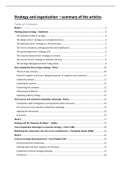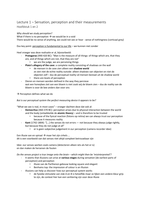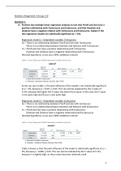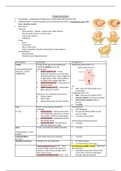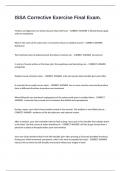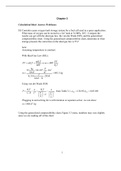Table of Contents
Week 1 .................................................................................................................................................... 4
Thinking about strategy – Stoelhorst ..................................................................................................... 4
The Standard model of strategy .......................................................................................................... 4
The design school: strategy as a conceptual process .......................................................................... 4
The planning school: strategy as a formal process ............................................................................. 5
The rise of consultants: selling powerful oversimplification............................................................... 6
The positioning school: strategy as fit ................................................................................................. 6
The resource-based school: strategy as a stretch ............................................................................... 7
The process school: strategy as collective learning ............................................................................ 8
The Strategic Management Field: Taking Stock .................................................................................. 9
How competitive forces shape strategy - Porter ................................................................................. 10
Threat of new entrants...................................................................................................................... 10
Powerful suppliers and buyers (Bargaining power of suppliers and customers) .............................. 11
Substitute products ........................................................................................................................... 11
Jockeying for position ........................................................................................................................ 12
Positioning the company ................................................................................................................... 12
Influencing the balance ..................................................................................................................... 12
Exploiting industry change ................................................................................................................ 12
Firm sources and sustained competitive advantage - Barley ............................................................. 13
Competition with homogeneous and perfectly mobile recourses ................................................... 13
Firm recourses and sustained competitive advantage ..................................................................... 14
Applying the framework .................................................................................................................... 15
Discussion .......................................................................................................................................... 15
Week 2 .................................................................................................................................................. 17
Strategy and the “Business Portfolio” – Hedley .................................................................................. 17
From Competitive advantage to corporate strategy – Porter 1989.................................................... 19
Rethinking the corporation: the role of core competencies – Prahalad & Hamel (1990) .................. 21
Week 3 .................................................................................................................................................. 22
A formal strategic planning process – Hax & Majluf 1991 .................................................................. 22
Hierarchical levels of planning .......................................................................................................... 22
Planning tasks and their sequence of execution ............................................................................... 22
Limitations of formal strategic planning ........................................................................................... 23
Conclusion ......................................................................................................................................... 24
,The fall and rise of strategic planning – Mintzberg (1994).................................................................. 25
Strategic planning vs. strategic thinking............................................................................................ 25
The pitfalls of planning ...................................................................................................................... 25
Fallacies (mistakes) of strategic planning .......................................................................................... 25
Planning, plans and planners............................................................................................................. 26
Limitations ......................................................................................................................................... 27
Conclusion ......................................................................................................................................... 27
Strategic Planning in a Turbulent Environment: Evidence from the Oil Majors - Grant, (2003) ....... 28
Week 4 .................................................................................................................................................. 29
Strategic decision making – Eisenhardt & Zbaracki (1992) ................................................................. 29
Rational model .................................................................................................................................. 29
Political model ................................................................................................................................... 30
The garbage can model ..................................................................................................................... 31
Future research ................................................................................................................................. 31
The organization as a reflection of its top managers – Hambrick & Mason (1984) ........................... 32
Development of the model ............................................................................................................... 32
Emphasis on observable managerial characteristics......................................................................... 32
The theory ......................................................................................................................................... 33
Propositions based on the theory ..................................................................................................... 33
Research program ............................................................................................................................. 34
Strategic change: logical incrementalism – Quinn (1989) ................................................................... 35
An incremental logic .......................................................................................................................... 35
Incrementalism in strategic subsystems ........................................................................................... 35
Formal planning is also incremental.................................................................................................. 36
Logical Incrementalism ...................................................................................................................... 36
Strategy as cognition – Mintzberg, Ahlstrand & Lampel (1998) ......................................................... 38
Week 5 .................................................................................................................................................. 39
Organizational transformation as punctuated equilibrium: an empirical test - Romanelli &
Tushman................................................................................................................................................ 39
Theory and hypotheses ..................................................................................................................... 39
Study and results ............................................................................................................................... 39
Discussion .......................................................................................................................................... 40
Organizational strategy, structure, and process – Miles, Snow, Meyer & Coleman (1978) .............. 41
The adaptive cycle: general model of adaptive process ................................................................... 41
Strategic typology: the means of moving through the adaptive cycle ............................................. 42
Management theory components .................................................................................................... 43
,An Ambidexterity Perspective Toward Multinational Enterprises From Emerging Economies – Rui &
Luo ......................................................................................................................................................... 45
Ambidexterity and EM MNE’s ........................................................................................................... 45
Ambidexterity as a multidimensional construct ............................................................................... 45
Week 6: strategy implementation ....................................................................................................... 47
Strategy implementation: five approaches to an elusive phenomenon (1984) ................................. 47
The Commander model ..................................................................................................................... 47
The Change model ............................................................................................................................. 48
The collaborative model .................................................................................................................... 48
The cultural model ............................................................................................................................ 49
The Crescive model ........................................................................................................................... 49
Having trouble with your strategy? Then map it – Kaplan & Norton (2000)...................................... 51
Breakdowns in Implementing Models of Organization Change – Van de Ven & Sun (2011) ............ 53
Breakdowns in models of change ..................................................................................................... 53
Complexities of interacting models, agents and changes ................................................................. 54
Reflecting on the strategy process – Mintzberg & Lampel (1999) ...................................................... 56
Opening up the schools ..................................................................................................................... 56
, Week 1
Thinking about strategy – Stoelhorst
In this teaching note, the author talks about some common strategy approaches in the world now.
Those consist of:
- The standard model of strategy
- Design school: strategy as a conceptual process
- Planning school: strategy as a formal process
- The rise of consultants: selling powerful oversimplifications
- The positioning school: strategy as a fit
Industrial organization economics
The work of Porter
- The recourse-based school: strategy as a stretch
The recourse based view
The work of Prahalad and Hamel
- The process school: strategy as collective learning
- The field of strategic management: taking stock
The Standard model of strategy
This is a three-step model. First you start with formulating the objective of the organization (also
taking into account stakeholders). Then you would go into the analytical phase: do an internal and
external analysis. You want to found opportunities, threats, strengths and weaknesses. Than you will
do a SWOT and formulate the strategic problems the firm phases in the industry. The next step will
be to generate strategic options to phase those issues. In choosing among these strategic options,
the firm should consider their suitability (does the strategy deal with the strategic issues?),
acceptability (is the strategy acceptable to the firm’s stakeholders?), and feasibility (will the firm be
able to execute the strategy?). The last stage would be the implementation phase.
All other schools have essentially added on this standard model int heir own way. In essence, it is the
joint product of two prescriptive schools of thought within the field of strategic management: the
design school and the planning school. Two more prescriptive schools of thought, the positioning
school and the resource-based school, have added substance to the way in which internal and
external analyses should be executed, although each of these two schools has done so on the basis of
its own particular view of what strategy is all about. However, a fifth school (process school) has
taken a problem with the message that this is the best way to tackle strategy. The process school is
primarily descriptive in nature: rather than telling managers what to do, authors in the process
school tend to observe how strategy actually takes shape in the everyday practice of firms. What
they find is typically quite different from the approach to strategy that the standard model
prescribes.
The design school: strategy as a conceptual process
A theory from the 1960’s typically regarding the work of Kenneth Andrews. At the core of this
approach is the idea that the specific characteristics of the firm should be confronted with the
external situation it faces. This idea has been made instrumental in the so-called SWOT analysis
(strengths, weaknesses, opportunities, and threats). Seven assumptions about strategy are made in
this school:

